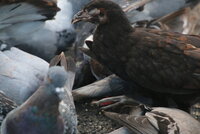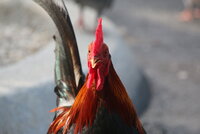Hi everyone!
while doing fieldwork last year in Key West Florida, I found myself surrounded by feral chickens. likely descended from Cuban cockfighting birds, the chickens that roam freely through the Florida keys are, while technically feral, they behave as truly wild birds. I have put down some observations of the behaviors of these "wild" chickens below that I wrote in the field.
general behavior:
Unlike many other birds in the region, Key West chickens are active all throughout the day. While these birds do move to shade in extreme heat, their activity never drops to the same level as that of a pigeon or sparrow. They rarely sleep until nightfall and feed constantly. Some individuals even remain in open areas during heavy downpours, unlike most birds that seek shelter in these times. Groups of KW chickens from loose flocks of up to 10 members, sometimes each bird is about 10 feet apart while feeding or simply moving from feeding site to feeding site. Drinking usually occurs out of puddles. Dust bathing is very common, and birds often use the same patch of ground day after day.
feeding:
KW chickens are constantly scratching at loose stones, grass, dirt, and sand. I have seen both earthworms and unidentified beetles in their bills. plant roots are also eaten, however, these are passed over for commercial birdseed or bread, which is sometimes offered to them by locals and tourists alike. If a piece of birdseed has been washed into a puddle, KWs have no problem fishing the seeds out and eating them. This aquatic foraging usually only occurs after rainstorms, when many possible food items have been washed into puddles.
breeding:
The egg-laying and brooding of KW hens commonly occur under, or near shrubbery. Hens take chicks as old as 6 weeks and in number from 1 to 12 on foraging trips close to the nest. It is unknown when the juveniles leave the adults. The plumage of young chicks is highly variable, but almost all have a horizontal eyestripe. The crowing of males occurs all throughout the day, and males will chase each other and spar if one gets to close to another. loose territories may be established.
predation:
Due to the fact that the environment is rather urban, natural predators to the KW chicken are rare, but humans, feral cats, and red-tailed hawks have been known to feed on adults and juveniles. Males are the most likely to alert the flock of a threat, but if in danger, females will also call. Both the alarm calls of the male and female are responded to in the same way, all members of the flock scatter, often taking shelter under bushes.
morphology:
large amounts of white plumage are not seen on any bird. Small white spots were seen on one rooster, and white primary feathers seem on another. Pale cream-colored hackles can be seen on some birds. Males tend to look all nearly the same- with crimson combs and faint white "ears". Hackles are usually a dark reddish color (but may be paler or darker) and tails are always glossy black (except in, mutant individuals who may have a few white feathers mixed in). Other colorations in males are more variable. females as a whole are also very variable, but have wide, erect tails that are only fully fanned in flight. Feathers are often heavily patterned and combs are pinkish with faint white "ears"
Habitat:
Preferred habitat includes areas with a large, open area covered in grass, dirt, small stones of asphalt, often surrounded, or dotted with low bushes for cover, and some sort of fresh water source. KW roosters tend to stay in the same general area (about a half to quarter acre) while hens are harder to track. it is likely, however, that they have similar habitat-related to behavior.
*Please note, these are just my own observations, use any information presented here at you own discression
all photos below were taken by me.
while doing fieldwork last year in Key West Florida, I found myself surrounded by feral chickens. likely descended from Cuban cockfighting birds, the chickens that roam freely through the Florida keys are, while technically feral, they behave as truly wild birds. I have put down some observations of the behaviors of these "wild" chickens below that I wrote in the field.
general behavior:
Unlike many other birds in the region, Key West chickens are active all throughout the day. While these birds do move to shade in extreme heat, their activity never drops to the same level as that of a pigeon or sparrow. They rarely sleep until nightfall and feed constantly. Some individuals even remain in open areas during heavy downpours, unlike most birds that seek shelter in these times. Groups of KW chickens from loose flocks of up to 10 members, sometimes each bird is about 10 feet apart while feeding or simply moving from feeding site to feeding site. Drinking usually occurs out of puddles. Dust bathing is very common, and birds often use the same patch of ground day after day.
feeding:
KW chickens are constantly scratching at loose stones, grass, dirt, and sand. I have seen both earthworms and unidentified beetles in their bills. plant roots are also eaten, however, these are passed over for commercial birdseed or bread, which is sometimes offered to them by locals and tourists alike. If a piece of birdseed has been washed into a puddle, KWs have no problem fishing the seeds out and eating them. This aquatic foraging usually only occurs after rainstorms, when many possible food items have been washed into puddles.
breeding:
The egg-laying and brooding of KW hens commonly occur under, or near shrubbery. Hens take chicks as old as 6 weeks and in number from 1 to 12 on foraging trips close to the nest. It is unknown when the juveniles leave the adults. The plumage of young chicks is highly variable, but almost all have a horizontal eyestripe. The crowing of males occurs all throughout the day, and males will chase each other and spar if one gets to close to another. loose territories may be established.
predation:
Due to the fact that the environment is rather urban, natural predators to the KW chicken are rare, but humans, feral cats, and red-tailed hawks have been known to feed on adults and juveniles. Males are the most likely to alert the flock of a threat, but if in danger, females will also call. Both the alarm calls of the male and female are responded to in the same way, all members of the flock scatter, often taking shelter under bushes.
morphology:
large amounts of white plumage are not seen on any bird. Small white spots were seen on one rooster, and white primary feathers seem on another. Pale cream-colored hackles can be seen on some birds. Males tend to look all nearly the same- with crimson combs and faint white "ears". Hackles are usually a dark reddish color (but may be paler or darker) and tails are always glossy black (except in, mutant individuals who may have a few white feathers mixed in). Other colorations in males are more variable. females as a whole are also very variable, but have wide, erect tails that are only fully fanned in flight. Feathers are often heavily patterned and combs are pinkish with faint white "ears"
Habitat:
Preferred habitat includes areas with a large, open area covered in grass, dirt, small stones of asphalt, often surrounded, or dotted with low bushes for cover, and some sort of fresh water source. KW roosters tend to stay in the same general area (about a half to quarter acre) while hens are harder to track. it is likely, however, that they have similar habitat-related to behavior.
*Please note, these are just my own observations, use any information presented here at you own discression
all photos below were taken by me.


